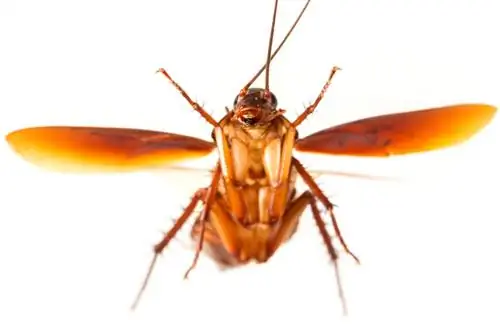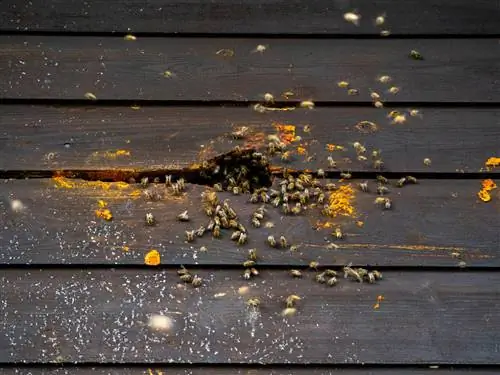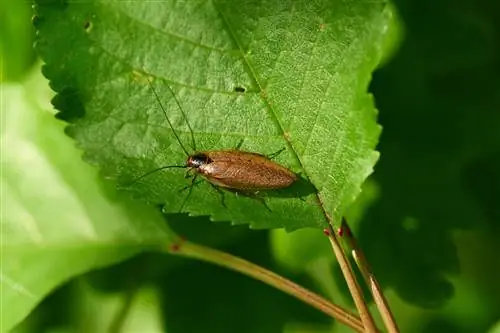- Author admin [email protected].
- Public 2023-12-16 16:46.
- Last modified 2025-01-23 11:22.
In the global ranking of the worst pests, cockroaches are clearly ahead - far ahead of bed bugs and other vermin. With an extensive repertoire of fatal abilities, cockroaches make people's lives miserable in homes, bakeries, restaurants and food establishments. Find out here whether the beasts can fly.

Can cockroaches fly?
Cockroaches can basically fly, but their ability to fly is severely limited. Male cockroaches can perform a short gliding flight, while females are unable to fly due to stunted wings. Baby cockroaches are also unable to fly.
- Cockroaches have wings and can fly.
- The ability of male cockroaches to fly is severely limited to a short gliding flight. Females are flightless due to stunted wings.
- Baby cockroaches cannot fly because wings only form in adult cockroaches.
Can cockroaches fly?
Yes, in principle cockroaches can fly. However, the ability to fly is massively limited and is in no way comparable to the flying skills of house flies, fruit flies and other nuisances. Like most insects, cockroaches have two pairs of wings. The flying machine is made up of sturdy, leathery outer wings and delicate hind wings. When at rest, the wings lie flat against the body.
Regardless of this, you will rarely if ever see a cockroach buzzing around your head. Often only male cockroaches have fully developed wings. Of course, there is little interest in flying around the house because cockroach ladies primarily move around on the ground. In many females, the wings are atrophied and no longer suitable for use. Sometimes they are just dummies because the necessary flight muscles are no longer available.
Excursus
Nimble legs and flexible exoskeleton
Limited flight does not prevent cockroaches from annexing buildings. The insects move extremely quickly on their three pairs of lateral legs, with top speeds of up to 1.5 meters per second - horizontally and vertically. A flexible exoskeleton enables cockroaches to use the tiniest cracks and crevices as hiding places.
Which cockroaches can fly?

Most cockroaches can fly
In the dark cockroach realm, having wings does not necessarily mean unlimited flight. In many cockroach species, wings have become insignificant over millions of years of evolution. A few species found in Europe were able to retain a certain degree of flight. The following table introduces you to the 5 most common species of cockroaches that can fly:
| scientific name | Size | color | Wings yes/no | Ability to fly | |
|---|---|---|---|---|---|
| German Cockroach | Blattella germanica | 13-16mm | brown to clay yellow | yes | limited, gliding |
| Common Cockroach | Blatta orientalis | 25-30mm | black to dark brown | yes | limited, gliding |
| American cockroach | Periplaneta americana | 34-53mm | red-brown | yes | good |
| Brown-banded cockroach | Supella longipalpa | 10-14 mm | yellow brown | yes | restricted |
| Forest Cockroaches | Ectobiinae | 9-14mm | brown to light brown | yes | good |
The following explanations shed light on the actual flight ability of each cockroach species:
German cockroach (Blattella germanica)
The dominant cockroach species in Germany and throughout Central Europe is the German cockroach, also known as the cockroach. In adults, the wings extend to the end of the abdomen. The flying apparatus is no longer usable on female cockroaches. At most, the slightly smaller and lighter males are capable of short gliding flights. Of course, this handicap doesn't stop the pests from darting through the building at top speeds of an impressive 30 meters per second. In addition, the insects can jump 5 to 10 centimeters.
Common cockroach (Blatta orientalis)
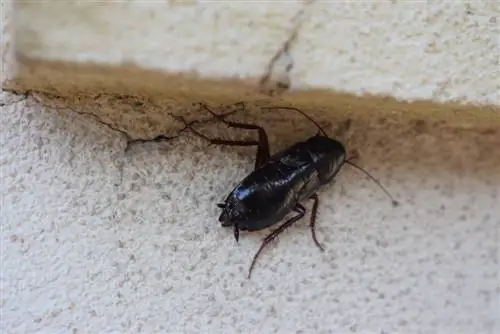
The common cockroach cannot fly and also has difficulty climbing
The common cockroach is also known as the baker's cockroach and the oriental cockroach. Along with the German cockroach, this type of cockroach is the most common type of cockroach to harass people in Germany and around the world. Smooth, curved wings are only present in males and are only suitable for short gliding flights. In female baker's cockroaches, the wings are atrophied into short stubs or are completely missing.
Because Oriental cockroaches are so large and heavy, they stay on the ground and don't run up the walls. To compensate for their severely limited or lost ability to fly, these cockroaches hold the speed record of a dizzying 150 centimeters per second. Smaller obstacles are not flown over, but rather jumped over.
American cockroach (Periplaneta americana)
Regardless of its name, the American cockroach is also unpopular in German buildings. Males and females have well-developed wings all the way to the end of the abdomen. In male animals, the wings extend beyond the abdomen. However, the insects rarely take advantage of the resulting unrestricted ability to fly. The pests prefer to rely on their strong legs, which allow them to move as quickly as possible. In order to overcome one or two stumbling blocks, the cockroaches don't even bother to unfold their wings, but instead overcome the obstacle with one jump.
Brown-banded cockroach (Supella longipalpa)
Under the name furniture cockroach, the smallest species of cockroach spreads fear and terror in Germany. The pest primarily targets all types of furniture where there is serious damage caused by damage. Both sexes can use wings up to the tip of the abdomen or beyond. The wings are usually only unfolded at high temperatures of more than 30 degrees Celsius.
Tip
Sighting a cockroach should not be taken lightly. Due to unbelievable reproduction rates, a plague of cockroaches is inevitable that surpasses any plague of mice. A German cockroach produces 40 new animals with a single package of eggs. If half of them are female, 20 x 40 more specimens, i.e. 800 cockroaches, will emerge within two months. After another two months you already have 400 x 40, i.e. 16,000 cockroaches on your neck.
Special case of forest cockroaches
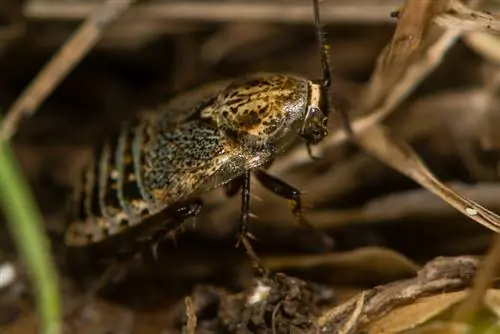
Forest cockroaches are beneficial insects and cannot fly
Forest cockroaches are the innocent victims of the worldwide cockroach aversion. In fact, forest cockroaches have a completely different lifestyle than cockroaches. Their habitat extends across deciduous and mixed forests. Forest cockroaches rarely get into buildings. Their downfall is that they look very similar to the dreaded German cockroaches (Blattella germanica). The following arguments explain why forest cockroaches occupy a special position:
- useful: Forest cockroaches are beneficial insects because they feed on decomposing plant waste
- harmless: no affinity for food or animal feed, no risk of disease transmission
- diurnal: mainly active in daylight, in contrast to the distantly related, nocturnal vermin
- flyable: equipped with functional flying apparatus
If forest cockroaches accidentally get into living spaces, it doesn't end well for the beneficial insects. Due to a lack of food, the insects die within a few days if they have not already been victims of a fly swatter.
Can baby cockroaches fly?
Baby cockroaches can't fly. This fact is based on a specific development cycle. Cockroach eggs develop into nymphs, not larvae. These are young animals that, even at a very early stage of development, look very similar to an adult cockroach, including rudimentary wings. The wings are only fully developed in adult cockroaches.
Frequently asked questions
Are cockroaches dangerous?
Cockroach infestations represent a high he alth risk for people, pets and farm animals. The insects contaminate stored food and animal feed with feces and other excretions. Furthermore, scientists have proven beyond doubt that cockroaches transmit diseases such as dysentery, cholera, tuberculosis, anthrax and salmonellosis. Molt residue and dried feces trigger asthma in susceptible people.
How can you recognize a cockroach infestation in the house?
You will rarely see a live cockroach. Cockroaches are nocturnal, very shy and lightning fast. Typical indications of the presence of the pests are damage to food supplies, a pungent smell, transparent remains of skin and crumbs of feces on walls and floors. The final certainty about cockroach infestation is provided by commercially available sticky traps (€12.00 on Amazon) with special attractants.
How do cockroaches get into the house?
Cockroaches often find their way into homes as stowaways in food packaging, second-hand kitchen appliances or holiday luggage. The pests also like to migrate from neighboring bakeries, restaurants or food factories. Cunning cockroaches use the smallest cracks and crevices as loopholes to nest in the house.
How can I prevent cockroach infestation?
Small structural measures are effective prevention. Seal all joints in the masonry. Eliminate door gaps, even if they are just a few millimeters. Avoid standing water in watering cans, buckets, basins and plant pot saucers. Check used electrical appliances such as refrigerators, washing machines or coffee makers for cockroaches and egg packets. Do not use old banana boxes or similar packaging to transport your purchases home.
What can you do against cockroaches in your home?
Deprive cockroaches of their livelihoods in the household. Always wipe up leftover food immediately. Regularly clean work surfaces, hard-to-reach niches, ovens, refrigerators and other heat-producing household appliances. Wash used dishes promptly and do not leave them in the sink overnight. Take all organic waste outside every evening. Cockroaches can easily bite through paper, cardboard and plastic wrap. Therefore, store supplies in closed containers made of glass, ceramic or porcelain.
Can cockroaches bite a person?
Cockroaches are equipped with powerful mouthparts. As omnivores, the pests make no distinction between vegetables, fruit, meat, cardboard, leather or human skin. However, cockroaches do not explicitly hunt humans to actively bite them, like blood-sucking insects. To date, only a few cases of people being bitten by a cockroach have been documented.
Tip
Cockroaches are phenomenally tough. It sounds like a horror scenario, but it is still based on scientific findings: cockroaches can live for a week without a head. Unlike humans, cockroaches do not rely on their heads to breathe. Oxygen is absorbed through small openings in the body. And the food intake? No problem for headless cockroaches, as they can go without any food for up to four weeks.

